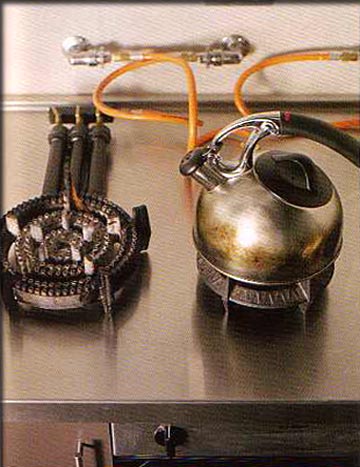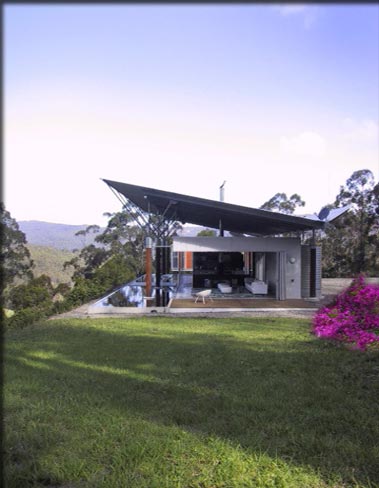

KANGAROO VALLEY HOUSE t
A weekend retreat
COMPLETED IN 2005
I‘ve talked myself horse when it comes to this project, so I’ve decided to copy and paste an article that was writen by Margie Blok for the Sydney Magazine, a monthly Sydney Morning Herald production. The two top photographs are by Anson Smart (aka Handsome Anson). All others are by yours truly.
HighLife
Built into the side of a mountain, this Kangaroo Valley weekender raises the stakes, writes Margie Blok
For most people, a 40-hectare, virtually inaccessible escarpment in Kangaroo Valley might not seem an obvious choice as a location for a weekender. But it took Tony White and Alexander Michael just 20 minutes to snap it up. Neither White, a jeweller, or Michael, an interior designer, was daunted by the prospect of building a house on the steep mountainside, which could only be reached by a precipitous winding track. In fact, the couple were inspired by the challenge. "We set five criteria for our ideal property: 100 acres, views, privacy, rainforest and natural water," says Michael. "This place has the lot."
Twelve months and some innovative design ideas later, the result is Wombat Towers, a futuristic solar powered house named after the burrowing mammals it attracts. "this area is full of wombats," says Michael. "Every time you drive up the road you have to be careful not to hit one." Near to top of the escarpment, the property has expansive views over the rainforest and dense bushland of the upper Kangaroo River. But the most striking thing is the house itself, which appears to defy gravity as there's only one fixed wall.
The soaring tent-like structure has irombark columns rising from a 27-meter long reflection pool to support a vast, butterfly-shaped roof made from galvanised steel. This acts as a sunshade and shelter (rather like the fly of a tent) for an enormous flat-roofed building with retractable glass on three sides. "With most houses, the walls support the roof, but this is different," explains Michael. "The upper roof supports the building beneath."
Michael designed the house as well as the interiors and much of the furniture.
A long timber walkway links the main building with a pair of freestanding cubes wrapped in timber louvers. Each cube houses a bedroom. I wanted this place to feel like a resort," explains Michael. "The outdoor walkways create the atmsphere." The house's vast proportions - the main bbuilding measures 20 meters long and seven meters wide and has no internal walls - add to the effect. A huge rectangular fireplace divides the sitting and dining zones, while a freestanding "Utility Pod" separates the kitchen from the media room. One side has an orange door opening to the guest loo, while the side for the media room has recesses for books and entertainment equipment. Another side conceals the laundry. Evident throughout is Michael's obsession with adapting commercial and industrial items for use in domestic settings. One ensuite has garden taps and a washbasin fashioned from a Dutch oven found in the local store. Toilet roll holders are made from chunky steel bolts. The kitchen has orange factory light switches, trolly wheels for door handles and catering style gas burners.
A South Coast builder took a year to complete Michael's modernist masterpiece, which encountered few obstacles. "But there was a memorable hiccup when the driver of an articulated truck missed our turn and hit the skinny dead end," he recalls. "A crane had to come from Nowra to turn it around.


The retreat is now the ideal escape from the couple's Potts Point home, which is an elegant, four storey Victorian terrace. "Every Friday night we load up the car and head down here for a change of pace," says White. During the cooler months, the house gives them a frosty reception. "It takes hours for the fire to warm the main living area, so we stick to the media room and flick on the gas heater." Taking centre stage in this space is another of Michael's designs - a grey sofa with an aluminium back. In contrast to pared-back functionality of the kitchen and dining space, Michael has given the chill-out zone a softer touch. Scattered across the polished concrete floor are sheepskins and floor cushions covered in thick brown felt.
Behind the sliding cupboard doors are 12 huge batteries storing the solar energy.

